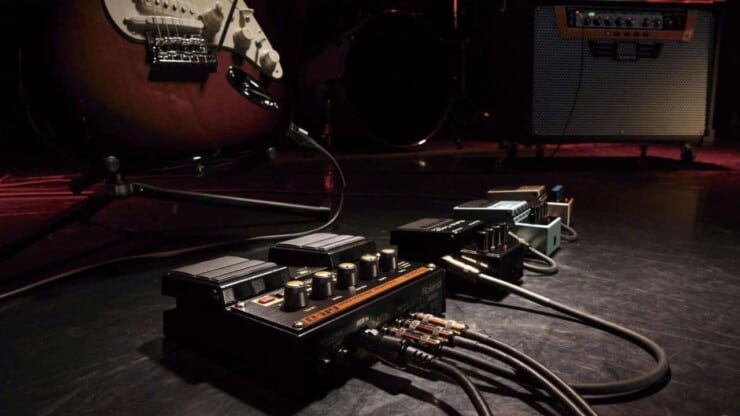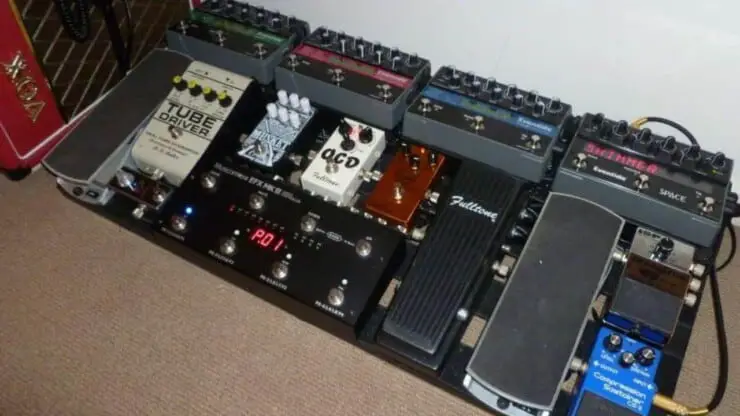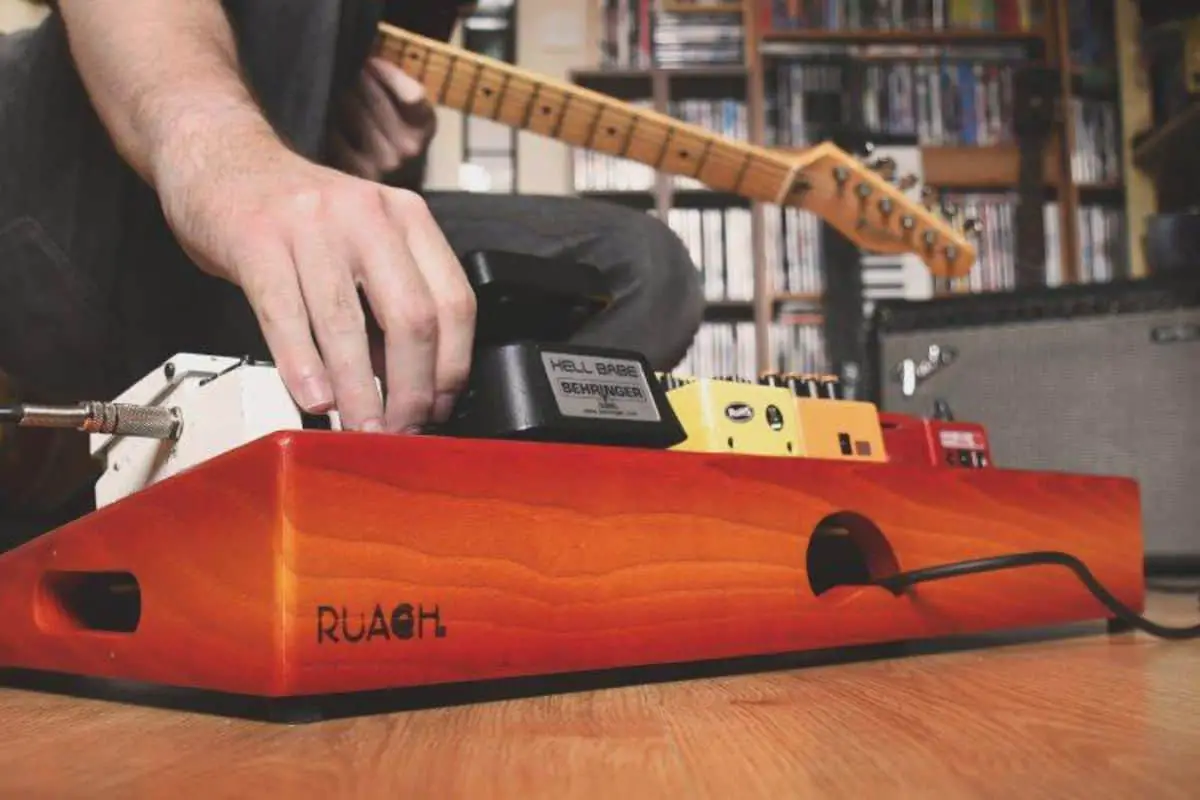Have you been getting unwanted noise from your pedalboard? If so, then it’s not a big issue. Once you find the source of the issue, you can easily troubleshoot it.
Pedalboard is so noisy due to many reasons, but the most common one is due to a bad or underpowered power supply. You can easily troubleshoot this issue and eliminate the unwanted noise coming out of the pedalboard.
In this article, you’ll get to know all about why is my pedalboard so noisy, the potential reasons for this noise, how to troubleshoot the problem, and the best ways to eliminate the noise from the pedalboard.
Having noise issues with your pedalboard?
This is an inevitable truth – most guitar rigs have to deal with hum and noise issues at some point. Whether you’re a beginner, a garage band, or a successful mainstream act, you’re bound to find yourself in a situation where you wonder why is my pedalboard so noisy? It can be easy to blame the sub-standard wiring when the pedalboard is making noise. However, ultimately, you’ll need to learn that a badly-designed signal chain with a cheap, unreliable power source is equally bad. It is truly a recipe for disaster and unwanted noise.
It cannot be stressed enough that the majority of problems come from bad, underpowered power supply and not faulty pedals. A general rule of thumb is that if the pedal is noisy, even if the effects are turned off, the culprit will likely be the power supply. At worst, the pedals will make a noise while the signal leaving the pedalboard will be a shadow of itself.
If you’re suffering from a noisy pedalboard, the first thing that you must check is the power supply. Have you been using a cheap power supply or maybe an underpowered power supply? If so, you should immediately switch to something more appropriate for the setup. This will help you make hum and buzzing an issue of the past.
Why is my pedalboard so noisy?
If your pedalboard is making noise, you’ll probably wonder what you need to do. There are many components in a guitar rig that could cause noise – power supply, speakers, amp, cables, and pedals. There are many possible reasons for weird noises and buzzes to occur. Weirdly, even cell phones, rooms, or the environment can create noise.
Here are a few ways that will get you wondering why is my pedalboard so noisy –
60-cycle hum or Ground loop
Ground loop is a commonly occurring hum that occurs when you’re using single-coil pickups. It can change depending on the room’s size, the electrical grounding of the building, or where you’re in the room. In most situations, this wouldn’t be that annoying of a noise. If the hum becomes too much, you can switch to a guitar with a double coil or a humbucker pickup. These types of pickups have got their names as they “buck” the annoying 60-cycle hum.
Tube amp noise
Tube amps, similar to analog electronics, have something known as the noise floor. This is a hissing sound that you get when turning a tube amp on. The hum shouldn’t drown out or interfere with your guitar playing. If the hissing gets too distracting, chances are that it isn’t just the analog noise floor of the tube amp. Tube amps can create plenty of problems in your guitar rid, although they sound superb normally. Loose tubes can sometimes cause noise, and bad tubes can easily ruin the sound. Bad tubes make all sorts of weird sounds, from making you sound quiet to making harsh echoing sounds.
When the tube amp starts making these sorts of sounds, and you’ve decided that it isn’t any other factor in the rig, it’ll be time to take the amp for a check-up. Servicing the tube amp regularly, similar to servicing the car, will make it such that you aren’t surprised by any major issues. For a decent amp expert and get the amps looked at if you’re looking to avoid these problems.
Cables
As mentioned previously, cables will be important and good working cables should be prioritized. If the cables aren’t working properly, you will likely encounter noise.

Speakers and cabs
There are many components to a guitar rig, and speakers and speaker cabinets will be important. Sometimes, speakers could come loose from the cabinet shell, and they will have to be tightened. The loose screws and rattling speakers can end up producing a lot of noise. Speakers having the wrong wattage (using a 60W speaker for a 100W amp) can end up producing noise. Lastly, ripped or broken speakers will sound horrible and produce a lot of unwanted noise. If a speaker is broken, there will be a tear in the cone, and it’ll make a weird buzzing sound. Ripped speakers could be repaired occasionally, but you should be ready to replace them.
Vintage pedals
Most of the pedals manufactured today are great at staying noise-free. However, if you often make use of vintage pedals, it can end up creating a lot of weird, unwanted noise. Meanwhile, old pedals or pedals with Germanium diodes, commonly used in fuzz pedals, could cause a lot of noise. If pedals are causing you trouble, it’ll be time to take them out of the live rig. Then, you can save them to record projects and other fun stuff where noise and hiss aren’t as stressful.
Power supplies
Lastly, having a big pedalboard will add many factors to the signal chain. Ensure that all the pedals are in proper working order. Meanwhile, the power supply should be high-quality, and it’ll help you get a clearer signal.
Troubleshoot to fix your noisy pedalboard
If you’re having noise issues and aren’t sure which part of the ring is causing it, the best way forward would be to narrow it down and check the different components. Plug the guitar directly into the amp. If you’re constantly getting noise, it’ll be likely from the guitar amp. The single cable that you’re using for connecting the two might also result in noise.
Check the cables
Use a cable tester or keep plugging cables into the working amp, and then run the signal through them. Additionally, move the cables around, especially the ends near the jack, and see if there are any loose connections.
Check the power supply
Ensure that you’re using the correct power supply for everything, while ensuring that the mA rating matches. Sometimes, daisy chains can cause more noise, and using a power brick as it’ll fix the noise problem.
Make use of a power conditioner
Sometimes, these will look similar to normal power strips. The power conditioner will improve the quality of power delivered to each unit that is consuming electricity. Improving and cleaning the power source will reduce noise greatly.
Use ground lift adaptors
These adaptors will take away the ground pin from the electrical plug, which makes it just two-pronged. Taking away the ground can sometimes cause issues, which means it’ll just be a temporary solution.
Plug in the pedals separately
This method is just what it sounds like, run each pedal in the chain individually and figure out what the problem is. This will be just as time-consuming as it’ll be effective.
Prefer using batteries
If your pedals can run on batteries, you should use them instead of a power supply. If it is eliminating the noise, then it’s the power supply that was causing the noise problem.
Eliminate noise in your distortion pedal
Sometimes, you’ll get unnecessary noise in the pedalboard, and you’ll be wondering why is my distortion pedal so noisy. There could be many reasons for this noise. Connecting different pedals and amps together can lead to noisy setups. Guitarists can easily turn to use noise gates as a means to try and eliminate the problem. They’ll not only rob tone, but they’ll also hamper the guitar’s attack time while limiting natural sustain. Here are some of the ways you can fix the noise problems with your distortion pedal.
Manage the power source
Most electrical systems used by guitarists around the world feature three conductors with power, common, and safety ground. Upon connecting two amps or effect pedals together, buzz or hum in the form of the ground loop can plague the guitar system. This problem can also be attributed to numerous other factors including DC voltages between two amps/effects, signals traveling through the audio grounds, and more. Some people will go as far as to remove the safety ground to find a viable solution. This practice is not only illegal, but it is unsafe and can potentially lead to death. The safety ground will be there for protecting your life.

You’ll need to start off by connecting all the amps and effects into a rack-mount power source or surge protector. This practice will ensure that the electric circuit supplying your equipment will be wired to the same phase. Some older homes come wired differently at different outlets, which means that you’re combining a hot wire with the ground. Bringing the electrical grounds together will reduce the risk and be a trick that studio engineers have long been using.
Lower the noise at the source
Electric guitars are simple devices that, for the most part, employ technology that’s been in use for over a century. Moving a piece of wire in and out of the magnetic field will generate current. This will be the basis of the electric guitar pickup. Once the signals are generated, they’ll be generated to the selector switch and volume controls using simple unshielded wires. As guitars are considered to be high impedance devices, they’ll be susceptible to noise. Moreover, as the pickups are open to capturing noise from nearby electromagnetic sources like power suppliers and transformers, fending off noise before they’re amplified can be advantageous.
A great option would be to add a copper or foil shield in the pickup and electronics cavity of your guitar. Copper shielding with adhesive on one side will work best. You should be careful when pushing the copper tight against the wood for ensuring that you’re not causing any electrical short. You must then shield the pickguard if you’re having a Strat-type guitar. All the shields should be tied together for creating a uniform shell around the electronics. It’ll then be grounded at the guitar jack.
Using high-quality coaxial guitar cables will help as well. Some quality cables will incorporate conductive plastic over the conductor and a served copper shield. This combination will produce fewer microphonics or self-noise from the cable once moved around or stepped on.
Eliminate ground loops
In any audio system, there will be two grounds. One of them will be the electrical safety ground, while the other will be the audio ground. When you’re connecting two pieces of gear together, you’ll be joining the two grounds together. It can easily create what is known as a ground loop. This will introduce a 50-60 cycle hum into the guitar system, which could be anywhere from slight to extreme depending on what equipment you’re using.
The best way of eliminating a ground loop would be to isolate audio sources from each other using a transformer. A transformer is essentially a magnetic bridge. In other words, the current will go into the primary coil and will be transformed into a magnetic field. The magnetic field will then be guided to a secondary coil, where the signal is produced. As the input and output aren’t connected, they’ll be magnetically bridged. Any DC noise that might be problematic will be eliminated. This is the case because transformers can only pass AC (Alternating Current) and not DC (Direct Current).
It’s important to note that not all transformers are created equal. High-performance transformers will be made by brands like Jensen employ nickel core materials, precise winding techniques, special ultra-thin wires, and types of shields. The passive devices will transfer the signal without actually introducing phase shift distortion or artifact.
Buffers and managing impedance
Electric guitars are often referred to as high-impedance of the hi-Z instrument. Where balanced mics come with an impedance of around 200 to 600 ohms, a guitar comes at around 7,000 to 16,000 ohms range. As high impedance circuits will be more susceptible to noise, a great option would be to buffer the signal before you drive a number of pedals or long cables. A buffer would be a unity gain amp that doesn’t boost the signal. It’ll merely drive it at a lower impedance, which will, in turn, reduce the noise.
Splitter
The Radial JD7 Injector is essentially a class-A guitar distro/splitter that comes with a built-in Radial DI and Reamp. It is capable of driving up to 7 amps or pedal chains simultaneously.
Even though this sounds easy, most tone-savvy guitarists will tell that they hate the sound of buffers. This is the case because most buffers employ Integrated Circuits for amplifying the signal. The chips will deliver massive amounts of positive gain (+) while also adding high amounts of negative feedback (-) for controlling the output. Combine them, and you’ll end up screwing things up. Radial buffers will employ discrete components and the unique class-A circuitry for eliminating negative feedback while maintaining the tonal integrity of the original signal.
Further, the sound of the tube circuit or guitar connected to the tube amp will sound different once a buffer has been introduced between the two devices. By adjusting the load using Drag Control, you’ll be able to tailor the tone for replicating the sound as if it’s connected directly to the amp.
Plug them all together
There are certain devices like fuzz pedals and wah-wahs that will react directly with the pickup. In simple words, if you’re placing a buffer in front of the wah pedal, it’ll sound different. A better solution would be to employ an effect pedal loop like the BigShot EFX that’ll allow you to take the fuzz and wah out of the circuit when not being used.
Conclusion
Thank you for reading. Hope you know a lot more about why is my pedalboard so noisy, the potential reasons for this noise, how to troubleshoot the problem, and the best ways to eliminate the noise from the pedalboard. Whether you’re a beginner, an indie band, or a mainstream act, at some point you will ask yourself “why is my pedalboard so noisy”. There are so many components involved with the guitar rig that if something isn’t right, there will be noise. Generally, pedalboards make noise due to either bad or underpowered power supply. To resolve this issue, you’ll need to find the source of the problem, troubleshoot it, and eliminate any unwanted noise coming out of your pedalboard.
Image Credit:
Featured Image: Ruach Music
Images: Roland, Pinterest



